现在分词和过去分词(知识梳理)
- 格式:doc
- 大小:44.00 KB
- 文档页数:7
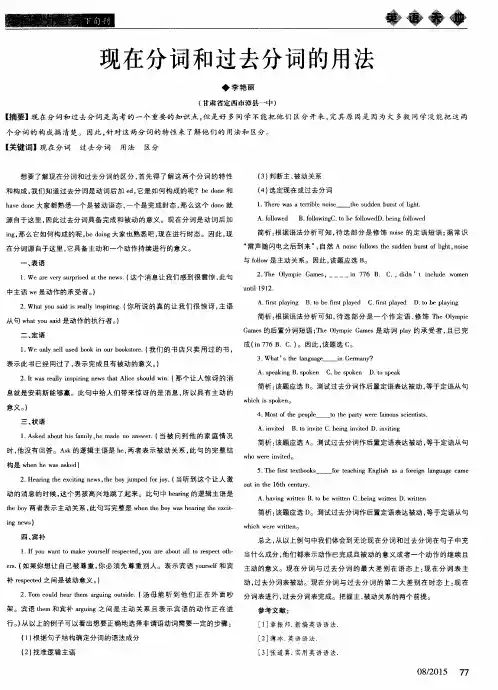

过去分词与现在分词被动式的区别文稿归稿存档编号:[KKUY-KKIO69-OTM243-OLUI129-G00I-FDQS58-过去分词与现在分词被动式的区别(1)过去分词在构成完成时态,不定式完成式以及被动语态时,通常不能用现在分词一般被动式代替。
(现在进行时的被动语态除外) eg:The door was closed an hour ago.这门在一小时前就关闭了。
They have finished their homework。
他们已经做完了家庭作业(2)过去分词作前置定语时,不能用现在分词一般被动式代替。
eg: That was an inspired suggestion.那是一条由某人提出的建议。
同样现在分词一般被动式作为定语表示动作时,也不能用过去分词来代替。
eg:The house being built is a big project.正在施工的那幢楼是一项大的工程。
(3)过去分词作条件、时间等状语时,不可用现在分词一般被动式代替。
eg:Given more time,I can do it better.(表条件)多给点时间,我会做得更好些。
Given more attention,the trees could have grownbetter.(MET 90)(表示条件)如果多关心一些,这些树会长得更好。
Heated ,the metal expands.(表示时间)加热后,这种金属会膨胀。
Asked why he did it,he said it was his duty .(表示时间) 问及为何要做此事时,他说这是他的职责。
(4)过去分词作表语时,不能用现在分词一般被动式代替。
eg:The top of the mountain is covered with snow .山顶满是雪。
(5)过去分词在构成have,get,want等动词后的复合宾语时,不能用现在分词一般被动式。
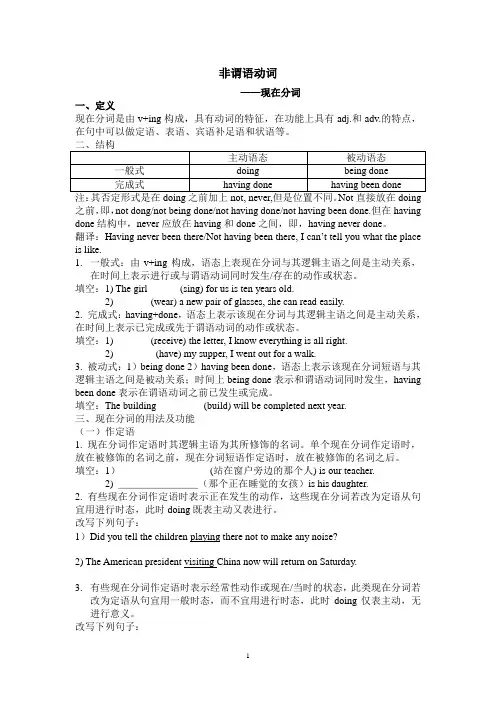
非谓语动词——现在分词一、定义现在分词是由v+ing构成,具有动词的特征,在功能上具有adj.和adv.的特点,在句中可以做定语、表语、宾语补足语和状语等。
之前,即,not dong/not being done/not having done/not having been done.但在having done结构中,never应放在having和done之间,即,having never done。
翻译:Having never been there/Not having been there, I can’t tell you what the place is like.1.一般式:由v+ing构成,语态上表现在分词与其逻辑主语之间是主动关系,在时间上表示进行或与谓语动词同时发生/存在的动作或状态。
填空:1) The girl ______(sing) for us is ten years old.2) _______(wear) a new pair of glasses, she can read easily.2. 完成式:having+done,语态上表示该现在分词与其逻辑主语之间是主动关系,在时间上表示已完成或先于谓语动词的动作或状态。
填空:1) _______(receive) the letter, I know everything is all right.2) ________(have) my supper, I went out for a walk.3. 被动式:1)being done 2)having been done,语态上表示该现在分词短语与其逻辑主语之间是被动关系;时间上being done表示和谓语动词同时发生,having been done表示在谓语动词之前已发生或完成。
填空:The building _________(build) will be completed next year.三、现在分词的用法及功能(一)作定语1. 现在分词作定语时其逻辑主语为其所修饰的名词。
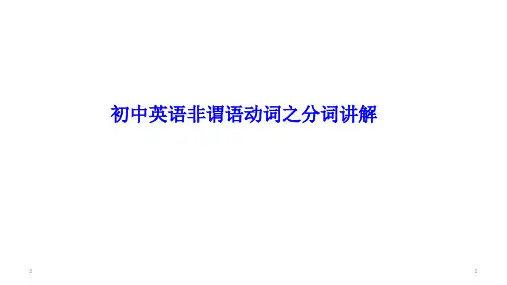
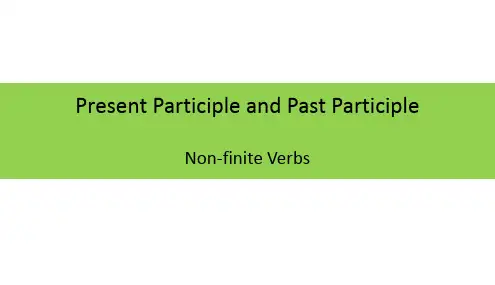
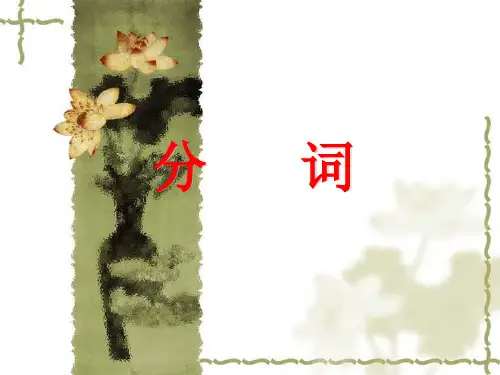
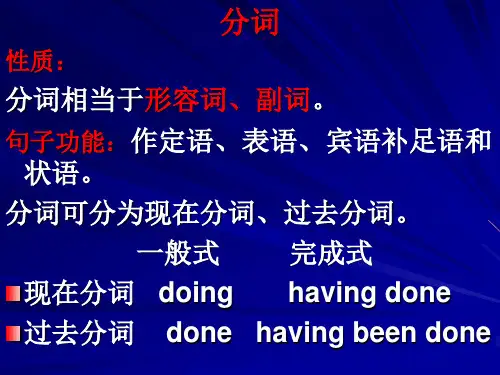
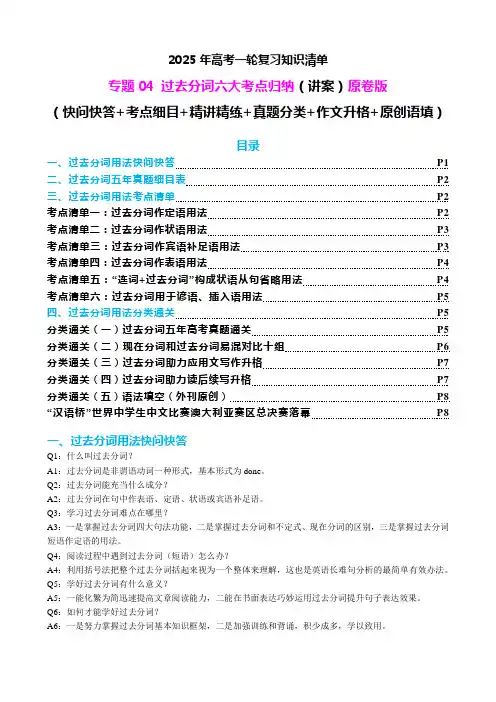
2025年高考一轮复习知识清单专题04 过去分词六大考点归纳(讲案)原卷版(快问快答+考点细目+精讲精练+真题分类+作文升格+原创语填)目录一、过去分词用法快问快答P1二、过去分词五年真题细目表P2三、过去分词用法考点清单P2 考点清单一:过去分词作定语用法P2 考点清单二:过去分词作状语用法P3 考点清单三:过去分词作宾语补足语用法P3 考点清单四:过去分词作表语用法P4 考点清单五:“连词+过去分词”构成状语从句省略用法P4 考点清单六:过去分词用于谚语、插入语用法P5 四、过去分词用法分类通关P5 分类通关(一)过去分词五年高考真题通关P5 分类通关(二)现在分词和过去分词易混对比十组P6 分类通关(三)过去分词助力应用文写作升格P7 分类通关(四)过去分词助力读后续写升格P7一、过去分词用法快问快答Q1:什么叫过去分词?A1:过去分词是非谓语动词一种形式,基本形式为done。
Q2:过去分词能充当什么成分?A2:过去分词在句中作表语、定语、状语或宾语补足语。
Q3:学习过去分词难点在哪里?A3:一是掌握过去分词四大句法功能,二是掌握过去分词和不定式、现在分词的区别,三是掌握过去分词短语作定语的用法。
Q4:阅读过程中遇到过去分词(短语)怎么办?A4:利用括号法把整个过去分词括起来视为一个整体来理解,这也是英语长难句分析的最简单有效办法。
Q5:学好过去分词有什么意义?A5:一能化繁为简迅速提高文章阅读能力,二能在书面表达巧妙运用过去分词提升句子表达效果。
Q6:如何才能学好过去分词?A6:一是努力掌握过去分词基本知识框架,二是加强训练和背诵,积少成多,学以致用。
三、过去分词用法考点清单考点清单一过去分词作定语用法【即时训练】用括号内所给单词的适当形式填空。
1. From the dates ____________ (mark) on the gold coin, we decided it was made five hundred years ago.2. Can those ____________/ ____________ (sit/seat) at the back of the classroom hear me?3. A team of scientists ____________ (lead) by a professor has found out that the monarch is able to tell the time of day.4. The club, ____________ (found) 25 years ago, is holding a party for past and present members.5. The old lady was so kind that she adopted many ____________ (abandon) cats and dogs.6. The house ____________ (build) there soon will be a library.7. There is a great deal of evidence ____________ (indicate) that music activities engage different parts of the brain.8. Foods ____________ (intend) for old people and children should be soft, tasty, small and light.9. With the government’s aid, those ____________ (affect) by the earthquake have moved to the new settlements.10. The traditional tea-making in China is a whole system ____________ (involve) knowledge, skills, and practices about the management of tea plantations, picking of tea leaves, manual processing, drinking, and sharing of tea.【即时训练】用括号内所给单词的适当形式填空。
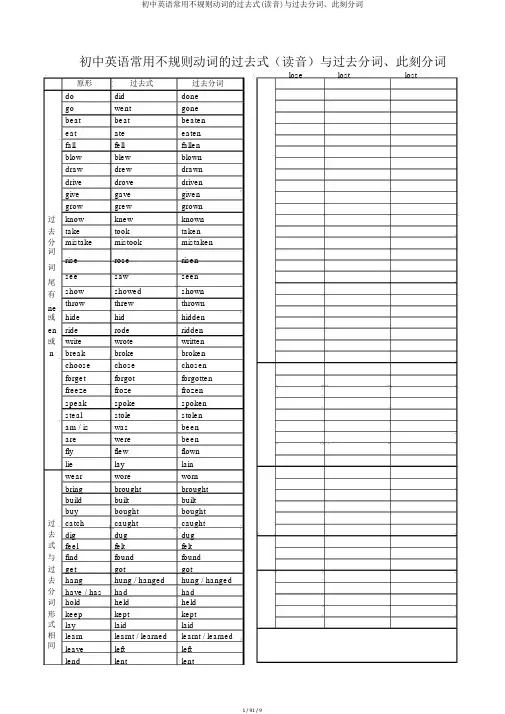
初中英语常用不规则动词的过去式(读音)与过去分词、此刻分词lose lost lost 原形过去式过去分词do did donego went gonebeat beat beateneat ate eatenfall fell fallenblow blew blowndraw drew drawndrive drove drivengive gave givengrow grew grown过know knew known去take took taken分mistake mistook mistaken词rise rose risen词see saw seen尾show showed shown有throw threw thrownne或hide hid hiddenen ride rode ridden或write wrote writtenn break broke brokenchoose chose chosenforget forgot forgottenfreeze froze frozenspeak spoke spokensteal stole stolenam / is was beenare were beenfly flew flownlie lay lainwear wore wornbring brought broughtbuild built builtbuy bought bought过catch caught caught去dig dug dug式feel felt felt与find found found过get got got去hang hung / hanged hung / hanged分have / has had had词hold held held形keep kept kept式lay laid laid相learn learnt / learned learnt / learned同leave left leftlend lent lent原形过去式过去分词hear heard heardmake made mademean meant meantmeet met metpay paid paidsay said said过sell sold sold去send sent sent式shine shone / shined shone / shined 与sit sat sat过sleep slept slept去smell smelt smelt分spend spent spent词spill spilt spilt形spit spat spat式spoil spoilt spoilt相stand stood stood同sweep swept sweptteach taught taughttell told toldthink thought thoughtunderstand understood understoodwake woke / waked woken / waked win won woncost cost cost三cut cut cut个hit hit hit形hurt hurt hurt式let let let全put put put相read /ri:d/ read /red/ read /red/同set set setshut shut shutbegin began beguni-drink drank drunka-ring rang rungusing sang sung形sink sank sunk式swim swam swumbecome became becomecome came comerun ran runcan could -情must must -态will would -动may might -词shall should -注意差别 catch, bring, think, buy, teach这几个词的过去式与过去分词初中英语不规则动词的过去式与过去分词概括一.过去分词词尾有字母-n1 .过去分词由原形加-ne 组成do-did-done go-went-gone2 .过去分词由原形加-en 组成beat-beat-beaten eat-ate-eaten fall-fell-fallen3 .过去分词由原形加-n 组成blow-blew-blown grow-grew-grown rise-rose-risen draw-drew-drawnknow-knew-knownsee-saw-seendrive-drove-driventake-took-takenshow-showed-showngive-gave-given mistake-mistook-mistaken throw-threw-thrown4 .过去分词由原形去字母 e 后,再双写后边的辅音字母加-en 组成(*例外)hide-hid-hidden ride-rode-ridden write-wrote-written forget-forgot-forgotten *5 .过去分词由过去式加-n 组成break-broke-broken choose-chose-chosen freeze-froze-frozen speak-spoke-spoken steal-stole-stolen6.完整不规则形式am / is-was-been are-were-been fly-flew-flown lie-lay-lainwear-wore-worn二.过去式与过去分词形式同样bring-brought-brought build-built-built buy-bought-bought catch-caught-caught dig-dug-dug feel-felt-felt find-found-found get-got-gothave / has-had-had hold-held-held keep-kept-kept leave-left-leftlay-laid-laid lend-lent-lent lose-lost-lost pay-paid-paidhear-heard - heard make-made-made mean-meant-meant meet-met-metsay-said-said sell-sold-sold send-sent-sent sit-sat-satsleep-slept-slept smell-smelt-smelt spend-spent-spent spill-spilt-spiltspit-spat-spat spoil-spoilt-spoilt stand-stood-stood sweep-swept-swept teach-taught-taught tell-told-told think-thought-thought win-won-wonunderstand-understood-understood wake-woke / waked-woken / wakedshine-shone / shined-shone / shined hang-hung / hanged-hung / hangedlearn-learnt / learned-learnt / learned三.原形、过去式与过去分词三种形式完整同样cost-cost-cost cut-cut-cut hit-hit-hit hurt-hurt-hurtlet-let-let put-put-put set-set-set shut-shut-shutread /ri:d/-read /red/-read /red/四. i-a-u变化形式begin-began-begun drink-drank-drunk ring-rang-rung sing-sang-sung sink-sank-sunk swim-swam-swum五.过去分词与原形同样come-came-come run-ran-run become-became-become六.神态动词(没有过去分词形式)can-could must-must will-would may-mightshall-should动词过去式变化规则及其读音规则来自 : VIPABC (真人在线,及时互动) 2011-01-21 10:15:30规则动词的过去式变化以下:1、一般状况下,动词词尾加-ed,如:work ---worked play--- played wanted----wanted act----acted2、以不发音的-e 结尾动词,动词词尾加-d ,如:live---lived move ----moved taste---tasted hope ---hoped3、以辅音字母+ y 结尾的动词,把 -y 变为 -i 再加 -ed ,如:study---studied copy--- copied cry---cried carry--- carried4、以一个辅音字母结尾的重读闭音节动词,双写词尾辅音字母,再加-ed ,如:stop ---stopped5、不规则动词的过去式变化规律性不强,须多加记忆。
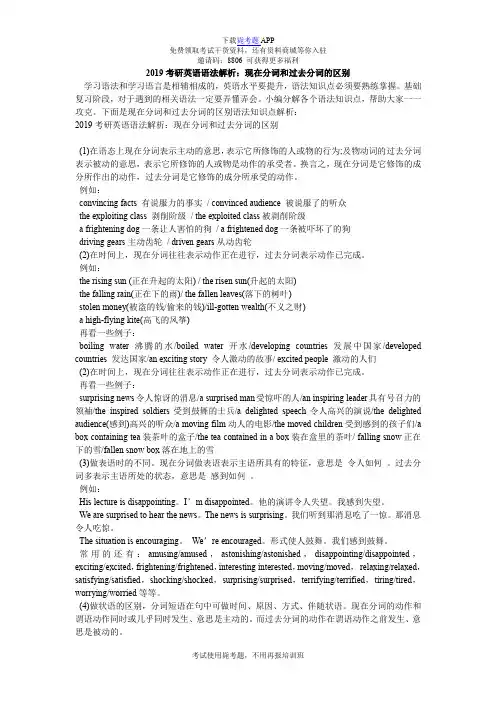
2019考研英语语法解析:现在分词和过去分词的区别学习语法和学习语言是相辅相成的,英语水平要提升,语法知识点必须要熟练掌握。
基础复习阶段,对于遇到的相关语法一定要弄懂弄会。
小编分解各个语法知识点,帮助大家一一攻克。
下面是现在分词和过去分词的区别语法知识点解析:2019考研英语语法解析:现在分词和过去分词的区别(1)在语态上现在分词表示主动的意思,表示它所修饰的人或物的行为;及物动词的过去分词表示被动的意思,表示它所修饰的人或物是动作的承受者。
换言之,现在分词是它修饰的成分所作出的动作,过去分词是它修饰的成分所承受的动作。
例如:convincing facts 有说服力的事实/ convinced audience 被说服了的听众the exploiting class 剥削阶级/ the exploited class被剥削阶级a frightening dog一条让人害怕的狗/ a frightened dog一条被吓坏了的狗driving gears主动齿轮/ driven gears从动齿轮(2)在时间上,现在分词往往表示动作正在进行,过去分词表示动作已完成。
例如:the rising sun (正在升起的太阳) / the risen sun(升起的太阳)the falling rain(正在下的雨)/ the fallen leaves(落下的树叶)stolen money(被盗的钱/偷来的钱)/ill-gotten wealth(不义之财)a high-flying kite(高飞的风筝)再看一些例子:boiling water 沸腾的水/boiled water 开水/developing countries 发展中国家/developed countries 发达国家/an exciting story 令人激动的故事/ excited people 激动的人们(2)在时间上,现在分词往往表示动作正在进行,过去分词表示动作已完成。
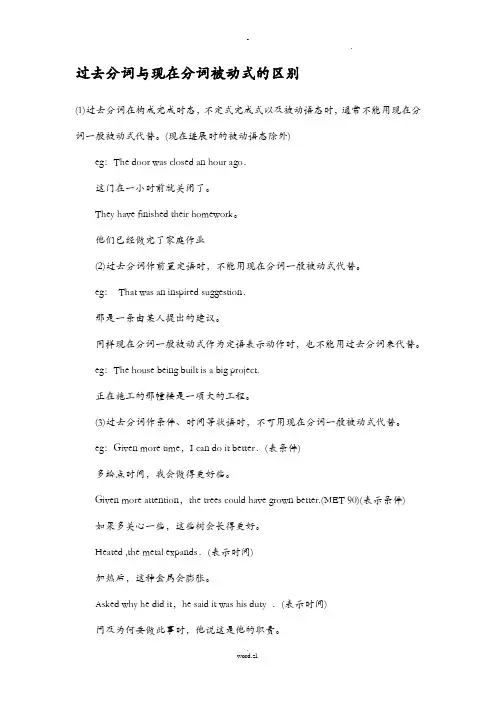
过去分词与现在分词被动式的区别(1)过去分词在构成完成时态,不定式完成式以及被动语态时,通常不能用现在分词一般被动式代替。
(现在进展时的被动语态除外)eg:The door was closed an hour ago.这门在一小时前就关闭了。
They have finished their homework。
他们已经做完了家庭作业(2)过去分词作前置定语时,不能用现在分词一般被动式代替。
eg:That was an inspired suggestion.那是一条由某人提出的建议。
同样现在分词一般被动式作为定语表示动作时,也不能用过去分词来代替。
eg:The house being built is a big project.正在施工的那幢楼是一项大的工程。
(3)过去分词作条件、时间等状语时,不可用现在分词一般被动式代替。
eg:Given more time,I can do it better.(表条件)多给点时间,我会做得更好些。
Given more attention,the trees could have grown better.(MET 90)(表示条件)如果多关心一些,这些树会长得更好。
Heated ,the metal expands.(表示时间)加热后,这种金属会膨胀。
Asked why he did it,he said it was his duty .(表示时间)问及为何要做此事时,他说这是他的职责。
(4)过去分词作表语时,不能用现在分词一般被动式代替。
eg:The top of the mountain is covered with snow .山顶满是雪。
(5)过去分词在构成have,get,want等动词后的复合宾语时,不能用现在分词一般被动式。
eg:Why don’t you have the radio fixed?你为什么不把收音机拿去修一修?尤其是一些感官动词,如:see,hear,find等后构成复合宾语时,过去分词和现在分词一般被动式意思完全不同。
规则动词词尾加-ed有三种读音:1. 在清辅音后读作[t]。
如:asked, helped, watched, stopped2在浊辅音和元音后读作[d]。
如:enjoyed, studied, moved, called3. 在t / d后读作[id]。
如:wanted, needed不规则动词的过去式见课本后的不规则动词表。
大体上归纳有以下几条记忆法:1. 以t结尾的词,过去式与原形相同。
如:put—put, let—let, cut—cut, beat—beat,cost—cost,hit—hit2. 以d结尾的词,把d变成t。
3. 以n结尾的词,在词后加t。
如:mean—meant, burn—burnt, learn—learnt4. 以ow / aw结尾的词,把ow / aw变成ew。
如:blow—blew, draw—drew, know—knew, grow—grew,throw—threw5. 含有双写字母的词,将双写改为单写,在词尾加t。
如:keep—kept, sleep—slept, feel—felt, smell—smelt,sweep—swept6.只去掉一个e:feed—fed,meet—met7. 闭音节词,改i为a。
如:sit—sat, swim—swam, ring—rang, drink—drank,sing—sang,begin—began,8. 开音节词,改i为o。
如:drive—drove, ride—rode, write—wrote,9.buy—bought, bring—brought, think—thought, catch—caught, teach—taughty—laid, say—said, pay—paid母鸡“下蛋”并“摆放”好后,“说”,“付钱”11.is/am—was, are—were, have/has—had, do—did, go—went, run—ran, see—saw, fly—flew, get—got, win—won, eat—ate, come—came, make—made, tell—told, take—took, fall—fell, speak—spoke, wear—wore, stand—stood, become—became, forget—forgot, hear—heard,can—could, will—would, shall—should, find—found不规则动词的过去分词变化形式1、AAA动词原形,过去式,过去分词相同cost ---cost ---- cost cut ---cut---cut hit ---hit---hit hurt ---hurt ---hurt let ---let ---let put ---put ---put read ---read ---read set ---set ---set shut ---shut ---shut spread--- spread--- spread2、ABA动词原形与过去分词相同become -----became ----- become come----came ----- come run---ran---run3、动词过去分词有两个burn ---burned/burnt---burned/burnt dream---dreamed/dreamt ---dreamed/dreamt learn ---learned/learnt ---learned/learnt smell ---smelled/smelt ---smelled/smeltspell ---spelled/spelt ---spelled/spelt4、在动词原形后加---en/n构成过去分词be---was/were—been beat-----beat----beaten drive ---drove----drivenride ---rode----ridden rise ---rose----risen eat----ate-----eatenfall---fell---fallen give----gave ----given shake ----shook---shakensee----saw---seen take---took---taken blow---blew---blowndraw---drew---drawn grow---grew---grown know---knew---knownshow---showed---shown throw---threw---thrown write—wrote---written5、动词原形i过去式a 过去分词ubegin ---began----begun sing ---sang ----sung ring ---rang---rungswim ---swam ----swum drink ---drank----drunk6、在过去式后加n构成过去分词break---broke ---broken forget ---forgot---forgotten choose---chose---chosen freeze---froze----frozen hide---hid---hidden speak---spoke---spoken steal---stole---stolen wake---woke---woken wear---wore---worn7、动词过去式与过去分词相同bring ---brought ---brought buy ---bought --bought fight ---fought ---fought think ---thought---thought catch ---caught ---caught teach ---taught ---taught dig---dug---dug feed---fed----fed find---found---foundget----got---got hang----hung----hung hear—heard---heardhold----held----held keep---kept----kept lay---laid---laidlead---led---led leave---left----left lend---lent---lentlose---lost---lost make----made---made mean---meant—meant meet---met---met pay---paid---paid say---said---saidsell---sold---sold send----sent---sent shine----shone----shonesit----sat----sat sleep----slept----slept spend---spent---spent stand----stood---stood stick----stuck----stuck sweep---swept---swept tell---told----told understand----understood---understoodwin---won---won feel---felt---felt have----had---had8、特殊记忆do---did---done go---went---gone动词过去式,过去分词不规则变化AB型can—could shall —should will—would may—mightAAA型cost—cost—cost cut—cut—cut hit—hit—hit hurt—hurt—hurt let—let—let must—must—must put—put—put set—set—set shut—shut—shut read—read—readAAB型beat—beat beatenABA型become became becomecome came comerun ran runABB型bring brought broughtbuy bought boughtthink thought thoughtcatch caught caughtteach taught taughtbuild built builtlend lent lentsend sent sentspend spent spentdig dug dughang hung hungfeel felt feltkeep kept keptsleep slept sleptsweep swept sweptleave left leftsmell smelt smeltspill spilt spiltlay laid laidpay paid paidsay said saidsell sold soldsit sat satspit spat spatstand stood stoodunderstand understood understood learn learnt learntmean meant meantspoil spoilt spoiltshine shone shonewin won wonhave had hadmake made madehear heard heardfind found foundhold held heldABC型begin began begundrink drank drunkring rang rungsing sang sungsink sank sunkswim swam swumblow blew blownfly flew flowngrow grew grownknow knew knownthrow threw throwndraw drew drawnshow showed shownbreak broke brokenchoose chose chosenforget forgot forgottenfreeze froze frozenspeak spoke spokenwake woke wokendrive drove driveneat ate eatenfall fell fallengive gave givenhide hid hiddenride rode riddenrise rose risentake took takenmistake mistook mistakenwrite wrote writtenam,is was beendo did donego went gonelie lay lainsee saw seenwear wore worn易错型show showed shown draw drew drawnfall fell fallenfeel felt felthold held heldhelp helped helped think thought thought thank thanked thanked take took takentalk talked talkedget got gotforget forgot forgotten meet met metmean meant meanthit hit hithide hid hiddenring rang rungbring brought brought eat ate eatenbeat beat beatenlie lay lainlay laid laidfind found found found founded founded buy bought bought bring brought brought learn learnt learnt hear heard heard。
现在分词语法知识点详解现在分词语法知识点详解现在分词既具有动词的一些特征,又具有形容词和副词的句法功能。
(1)现在分词的形式:否定式:not + 现在分词现在分词的主动语态:现在分词主动语态的一般式表示与谓语动词所表示的动作同时发生,完成式表示的动作在谓语动词所表示的动作之前发生,常作状语。
例如:They went to the park, singing and talking. 他们边唱边说向公园走去。
Having done his homework, he played basket-ball. 做完作业,他开始打篮球。
现在分词的被动语态:一般式表示与谓语动词同时发生的被动的动作,完成式表示发生在谓语动词之前的被动的动作。
The problem being discussed is very important. 正在被讨论的问题很重要。
Having been told many times, the naughty boy made the same mistake.(2)现在分词的句法功能:①现在分词作定语,当分词单独做定语时,放在所修饰的名词前;如果是分词短语做定语放在名词后。
In the following years he worked even harder. 在后来的几年中,他学习更努力了。
The man speaking to the teacher is our monitor's father.正与老师谈话的那个人是我们班长的父亲。
现在分词作定语相当于一个定语从句的句法功能,如:in the following years也可用in the years that followed; the man speaking to the teacher可改为the man who is speaking to the teacher.②现在分词作表语:The film being shown in the cinema is exciting. The present situation is inspiring. 鼓舞人心。
英语分词知识点总结初中一、分词的种类1. 现在分词:一般由动词原形后加-ing构成,如going, running, playing等。
现在分词常用于表示正在进行的动作、原因、结果、时间、方式等。
2. 过去分词:一般由动词原形后加-ed、-en、-t构成,如gone, seen, spoken等。
过去分词常用于表示被动、完成、顺序、状态等。
二、分词的用法1. 现在分词作主语:Reading books is my hobby. (读书是我的爱好。
)2. 现在分词作宾语:I enjoy swimming. (我喜欢游泳。
)3. 现在分词作定语:The running water is so clear. (流动的水很清澈。
)4. 现在分词作状语:He left, feeling very happy. (他离开时感到非常开心。
)5. 过去分词作定语:The broken window needs to be repaired. (破损的窗户需要修理。
)6. 过去分词作宾语补足语:I have seen the film. (我看过这部电影。
)三、常见错误及对策1. 错误:使用动名词时误用定冠词对策:正确表达应为Doing exercise is good for your health. (做运动对你的健康有好处。
)2. 错误:误用现在分词与现在进行时的区分对策:正确表达应为He is talking on the phone now. (他现在正在打电话。
)3. 错误:误用现在分词和过去分词的区分对策:正确表达应为The children are interested in playing computer games. (孩子们对玩电脑游戏很感兴趣。
)4. 错误:误用分词短语对策:正确表达应为Having finished her homework, she went to bed. (她完成作业后去睡觉了。
现在分词和过去分词 真题再现 1. Like ancient sailors, birds can find their way____ the sun and the stars. A. used B. having used C. using D. use 2. In recent years an English word "infosphere" has appeared, _______the sense of “information” and "atmosphere". A. combine B. combined C. combining D. being combined 3. The park was full of people _________ themselves in the sunshine A. having enjoyed B. enjoyed C. enjoying D. to enjoy 4. ______ for two days, Steve managed to finish his report on schedule. A. To work B. Worked C. To be working D. Having worked 5. Listening to music at home is one thing, going to hear it _______ live is quite another. A. perform B. performing C. to perform D. being performed 6. ____ in the poorest area of Glasgow, he had a long, hard road to becoming a football star. A. Being raised B. Raising C. Raised D. To raise 7. ______in painting, John didn’t notice evening approaching. A. To absorb B. To be absorbed C. Absorbed D. Absorbing 8. Little Tom sat watching the monkey dancing in front of him. A. amaze B. amazing C. amazed D. to amaze 9. Back from his two-year medical service in Africa, Dr. Lee was very happy to see his mother _______ good care of at home. A. taking B. taken C. take D. be taken 10. Video games can be a poor influence if ________ in the wrong hands. A. to leave B. leaving C. leave D. left 11. If ___for the job, you’ll be informed soon. A .to accept B. accept C. accepting D. accepted 12. Much time ________ sitting at a desk, office workers are generally troubled by health problems. A. being spent B. having spent C. spent D. spending 13. When the clerk saw a kind of face wrinkled in an apologetic smile, she stood rooted to the ground, _________ whether to stay or leave. A. wondering B. wonder C. to wonder D. wondered 答案与解析: 1. C。句意:像古代的水手一样,鸟儿们能够利用太阳和星星发现他们的行程。birds和use之间是主动关系,故D正确。 2. C。现在分词表示主动的关系,而过去分词通常表示被动的关系。根据该句意思:最近几年,一个叫做infosphere的英语单词出现了,结合了“信息”和“气氛”这两个单词。这里的结合与前面新出现的单词的关系是主动的,故选C。 3. C。本题考查非谓语动词作定语,对于people来说是“主动享受”,而且和there be的状态同步进行,选现在分词作定语。 4. D。句意:工作了两天,Steve成功地按时完成了他的报告。句中的逻辑主语为Steve,与work之间为主动关系,故用现在分词,又因为强调已经工作两天了,所以用现在分词的完成式having worked,表示动作的先后性。故选D。 5. D。句意:在家里面听音乐是一回事,去到现场听又是另一回事。hear sb/sth doing 听到某人某物做某事。由于音乐是被演奏的,所以需要被动,所以选D。 6. C。句子主语he和raise(及物动词,抚养)之间是被动关系,A表被动、进行,C被动完成。故C正确。 7. C。本题考查的是过去分词的用法。句意:全神贯注于绘画中,约翰没有注意到傍晚来临了。短语be absorbed in全神贯注于,在句中作状语表状态,be省略。故选C。 8. C。句意:小Tom坐在那儿看猴子在他面前跳舞,感到无比惊讶。过去分词变成的形容词在句子作状语,表示状态。过去分词表示人的感觉,所以选C。 9. B。考查非谓语动词的过去分词的用法,his mother和take care of 是被动关系,用过去分词做宾语不足语。 10. D。句意:如果电子游戏落入一个错误的人手中就能够产生一个不良影响。 11.D。句意:如果录用你了,我们将很快通知你。根据选项可知本题考查非谓语动词。本题非谓语动词的主语为“you”,根据题意得知,与选项“accept”构成被动关系,因此选择“accepted”。 12. C。本题考查过去分词做定语,spend和time之间是被动关系,所以用过去分词。 13. A。句意:当店员看到一张漂亮的脸上挤出一副抱歉的笑容时,她像扎根似的定在了那里,想着是去是留。此句的谓语动词是stood,所以wonder在此用ing形式作一个伴随状语。故选A。
知识讲解 现在分词的时态 过去分词没有时态形式的变化,此处只讲现在分词的时态形式。 一般式:doing 完成式: having done 完成被动式:having been done 现在分词一般式表示动作与谓语动作同时发生,或在谓语动词所表示的动作之前或后发生。 Working together with Dr. Bethune, we learnt a lot from him. Knowing that they were going abroad next week, they began to make preparations. He came up to me,saying “Glad to see you again.” 现在分词完成式表示动作发生在谓语动作之前,常常用作状语,表示时间或原因。 Having done his homework, the schoolboy began to write his diary. (having done his homework发生在began之前,表示时间。) Not having done it right, I tried again. (not having done发生在 tried之前,表示原因。) Having been told to keep silent, they didn’t say a word.
分词的否定结构 现在分词的否定式由not后加现在分词构成: Not knowing what to do, she went to the teacher for help. I left at noon, not staying for lunch. 过去分词表否定时,常借助un-等前缀表示。 The boy was left uncared for.
区别动名词和现在分词 二者形式完全相同,都是由动词原形加-ing构成。但是它们之间有根本的区别,它们除了都具有动词特征以外, 现在分词还具有形容词和副词特征,而动名词则具有名词特征。 现在分词在句中可充当定语、表语、补语(宾语补足语或主语补足语)、状语;动名词在句中可充当主语、宾语、同位语、表语、定语。 如果-ing形式在句中充当状语和补语,那么它一定是现在分词。 Hearing the news, he got very excited. (hearing 作时间状语) I saw him going upstairs. (going作宾语补足语) 如果-ing形式在句中充当主语、宾语或同位语,那么它一定是动名词。 Studying English is our task. (studying作主语) He likes playing football. 他喜欢踢足球。 (playing作宾语) His ambition, conquering the whole world, was never fulfilled. (conquering作同位语,是动名词。) 如果-ing形式在句中充当表语,-ing形式可能是现在分词,也可能是动名词。区分方法是:如果-ing形式相当于一个名词,与主语处于同等地位,可以与主语交换位置,那么它就是动名词;如果-ing形式相当于一个形容词,表示主语的性质或特征,不可以与主语交换位置,那么它就是现在分词。 His work is repairing bikes.= Repairing bikes is his work. (repairing为动名词) The novel is interesting. (该句的表语与主语不能交换位置,interesting为现在分词。) 如果-ing形式在句中充当定语,那么它可能是现在分词,也可能是动名词。区分办法是:如果被修饰的名词与-ing形式之间有逻辑主谓关系,那么-ing形式就是现在分词;否则,-ing形式是动名词。 a sleeping car=a car for sleeping (sleep与car没有逻辑主谓关系) a sleeping boy= a boy who is sleeping (sleep与boy有逻辑主谓关系)